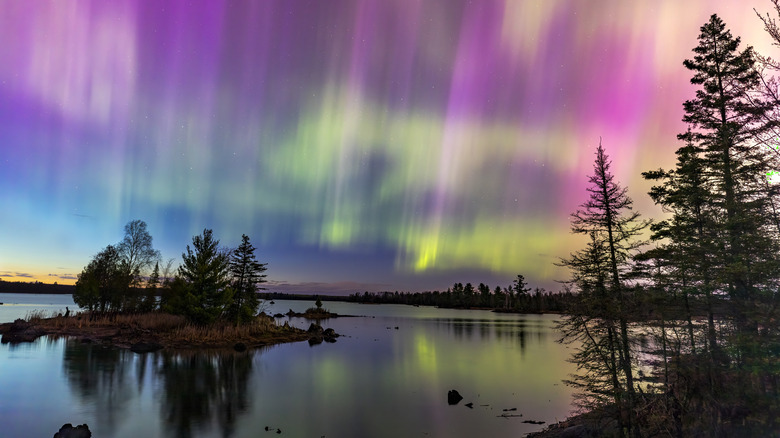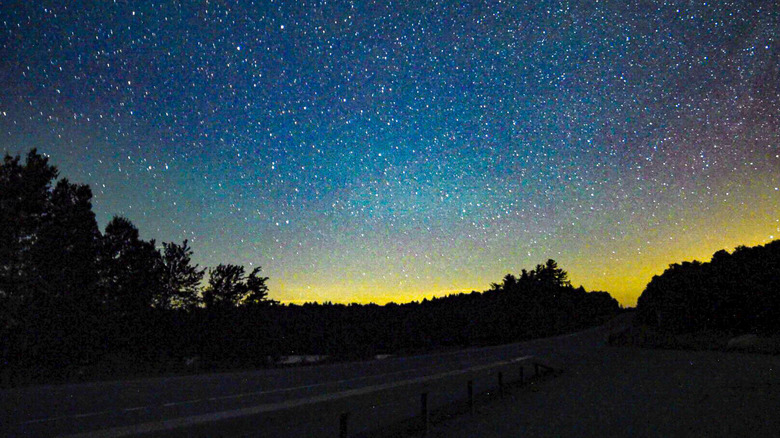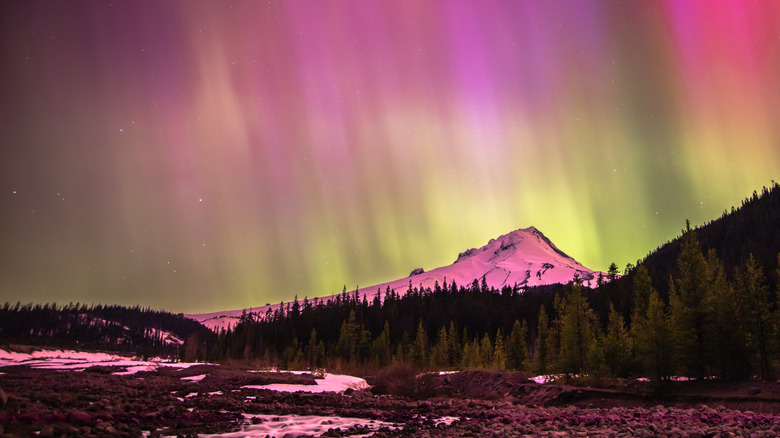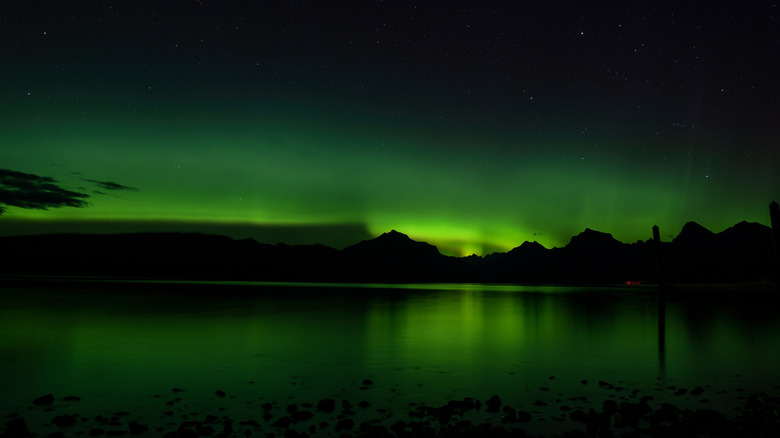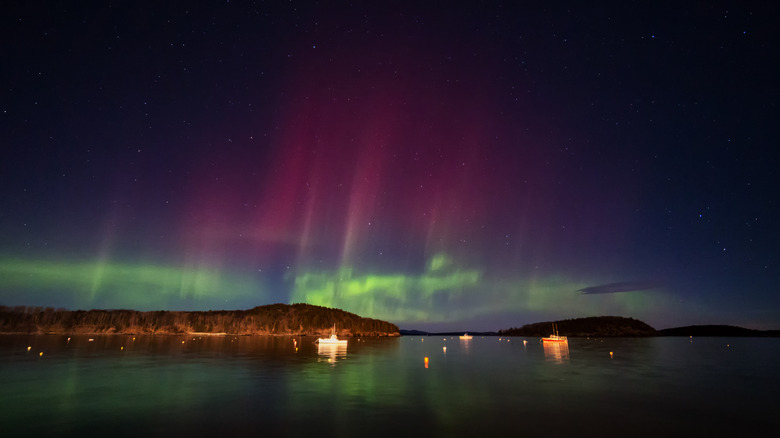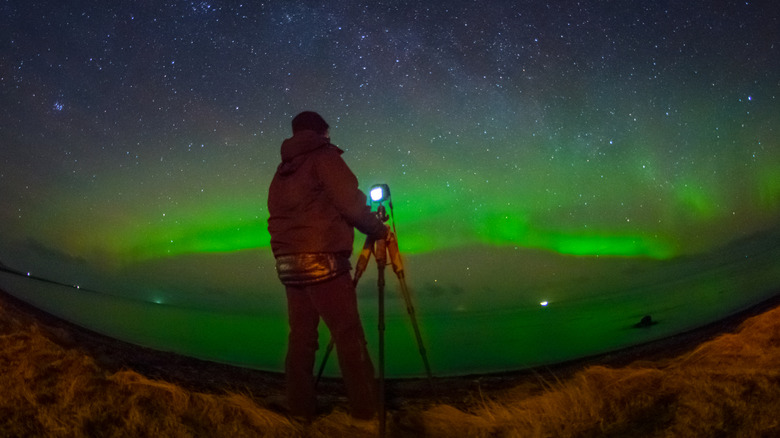America's 5 Most Breathtaking Destinations You Didn't Know Offer Northern Lights Views
Seeing the Northern Lights is a staple on most travelers' bucket lists — and for good reason. Seeing swaths of colored lights paint the skies is one of Mother Nature's most magical sights. But what makes this spectacle even more magical is the science behind it, where excitable electrons collide with nitrogen and oxygen in Earth's atmosphere, which in turn emit energy in greenish-yellow, blue, or red hues.
Many travelers assume that seeing the aurora borealis involves international travel, the warmest winter gear, and expensive accommodations — something along the lines of a picturesque glass igloo in one of the world's best resorts, perhaps. But here's good news for those without the time or budget for an intense overseas trip: America has some amazing Northern Lights viewing spots, many of which remain surprisingly under the radar.
After scouring travel features, curated lists, forums, and blogs, we narrowed down five breathtaking destinations across the United States to watch the Northern Lights without the tourist crowds, online hype, or international price tags. So bundle up and get ready for a fantastic light show.
Idaho Panhandle National Forest, Idaho
Idaho's obscurity as a Northern Lights destination works in its favor, guaranteeing dark skies and solitude for aurora watchers and photographers, especially around the Idaho Panhandle National Forest in the northern part of the state. Although pinpointing aurora borealis activity can be challenging, your chances improve significantly by taking note of key sighting indicators. Plan your visit between September and March, particularly during the weeks bookending a new moon. Weather-related resources like the Clear Sky Chart or the Geophysical Institute's 27-day aurora forecast are good sources to check beforehand.
Free from light pollution, Priest Lake in the Idaho Panhandle National Forest is a popular destination for hopeful aurora enthusiasts. Many head over to Hill's Resort, nestled along the eastern part of the lake, to marvel at the colorful light show reflecting on the calm waters. Farther south, Chatcolet Lake in Heyburn State Park — Idaho's oldest park with hidden beaches and bridges — offers stunning views of the Northern Lights under the right meteorological conditions. For elevated viewing, Schweitzer Mountain is another popular spot to witness this majestic phenomenon.
Adirondack Sky Center & Observatory, New York
While New York City's skyline is awash in neon lights, a different (and more natural) light show dazzles five hours north in the Adirondacks. The combination of high altitude and minimal artificial light makes Tupper Lake's Adirondack Sky Center & Observatory an ideal destination for viewing both the cosmos and the elusive Northern Lights. Located within Adirondack Park — a recognized International Dark Sky location recognized for its stargazing and astrotourism — the observatory is a hidden gem for aurora chasers. The center has a roll-off-roof observatory with four available mounted telescopes. When conditions permit, you can drop in on Friday evenings with other stargazers for free skywatching sessions.
The hunt for the Northern Lights doesn't end here. Aurora enthusiasts have reported sightings from Brant Lake, Upper St. Regis Lake, and Seventh Lake near Rocky Mountain Summit — areas offering expansive spaces and little light pollution. South of the park, Great Sacandaga Lake's Batchellerville Bridge has also been gaining Northern Lights chasers, especially on forecasted nights.
Given its unpredictability, maximize your chances by consulting the National Oceanic and Atmospheric Administration's (NOAA) Space Weather Prediction Center, which provides 30-minute forecasts on aurora locations and intensity. As for timing, the 11 p.m. to 2 a.m. window seems to be the sweet spot for aurora activity.
Oregon Outback International Dark Sky Sanctuary, Oregon
In early 2024, the Oregon Outback — a 2.4-million-acre landscape spanning deserts, mountains, and river canyons — was bestowed the title of the world's largest dark sky sanctuary by DarkSky International, with environmental consultant and DarkSky delegate Dawn Nilson praising the Outback's skies as "a starry refuge for people and wildlife alike." While Northern Lights are rare this far south of the auroral oval, strong geomagnetic storms — ranging from moderate G3 to extreme G5 levels — occasionally regale residents with unexpected aurora sightings in the Oregon Outback.
During periods of intense geomagnetic activity, the Columbia River Gorge, the Oregon Coast, and Mount Hood National Forest — all known for their dark skies and high elevation — offer the best chances of catching a Northern Lights display. Check the NOAA website, as well as Aurora Alerts or SpaceWeatherLive apps, for heads-ups on possible sightings. And if the Northern Lights are a no-show, you'll at least still get to enjoy Oregon Outback's breathtaking star-studded skies.
Glacier National Park, Montana
Montana's Glacier National Park is another popular place for possible Northern Light sightings. The months of October through March offer the best viewing window, though auroras have been spotted during the summer months as well. Find yourself with uninterrupted, north-facing views in remote locations away from artificial light sources.
Most aurora chasers position themselves along the shores of Lake McDonald, Glacier National Park's largest lake, framed by spectacular mountains on the horizon. Capturing the green hues reflected on the lake's surface is any photographer's dream shot. Along Looking Glass Road (Highway 49), a route beloved by wildlife enthusiasts, several roadside pullouts offer ideal vantage points for spotting the Northern Lights.
If you're up for adventure, head near the Canadian border to Bowman Lake, where you can pitch a tent at the lakeside campground with a thermos of coffee to keep you alert from 10 p.m. to 2 a.m., when auroras are most likely to appear. You can also push farther by hiking the 36-mile trail from Bowman to Kintla Lake, where another campground — and more aurora-viewing opportunities — await.
Acadia National Park, Maine
Maine's Acadia National Park hosts a wealth of postcard-worthy scenery to explore. But time your visit during a geomagnetic storm, and you just might catch this park's most breathtaking celestial offering: The Northern Lights. Locals have confirmed Northern Lights sightings from within the park, putting to rest concerns that light pollution from nearby Bar Harbor could obscure the view.
High-altitude spots such as the top of Cadillac Mountain offer unobstructed north-facing views — the best seats for aurora watching — though reaching them may entail some winter hiking, as cars are prohibited during the colder months. Sand Beach and Jordan Pond are more accessible spots in the park, while farther inland, Blackwoods Campground offers darker skies and prime viewing conditions.
Outside the park, Maine has two recognized Dark Sky Places: Katahdin Woods and Waters National Monument and the Appalachian Mountain Club (AMC) Maine Woods. Far from light pollution, the skies make wonderful canvases for the Northern Lights. August to October are the best months to spot auroras, especially on clear nights when the Kp index — a measure of magnetic field disturbance — reaches 5 or higher.
Methodology
To identify the five most breathtaking American destinations for viewing the Northern Lights, we consulted curated lists from websites including, but not limited to Travel + Leisure, Outside, U.S. Park Pass, and USA Today. We then evaluated each location based on factors like dark sky designation, accessibility, frequency of aurora sightings, and visitor feedback by reviewing official websites related to each destination.
We also scoured and examined blog posts and Reddit threads (r/Adirondack and r/AskAnAmerican) for first-hand information on Northern Lights sightings. Scientific context was drawn from official sources, including DarkSky International, NASA's Polar, Wind, and Geotail, and the National Oceanic and Atmospheric Administration.
